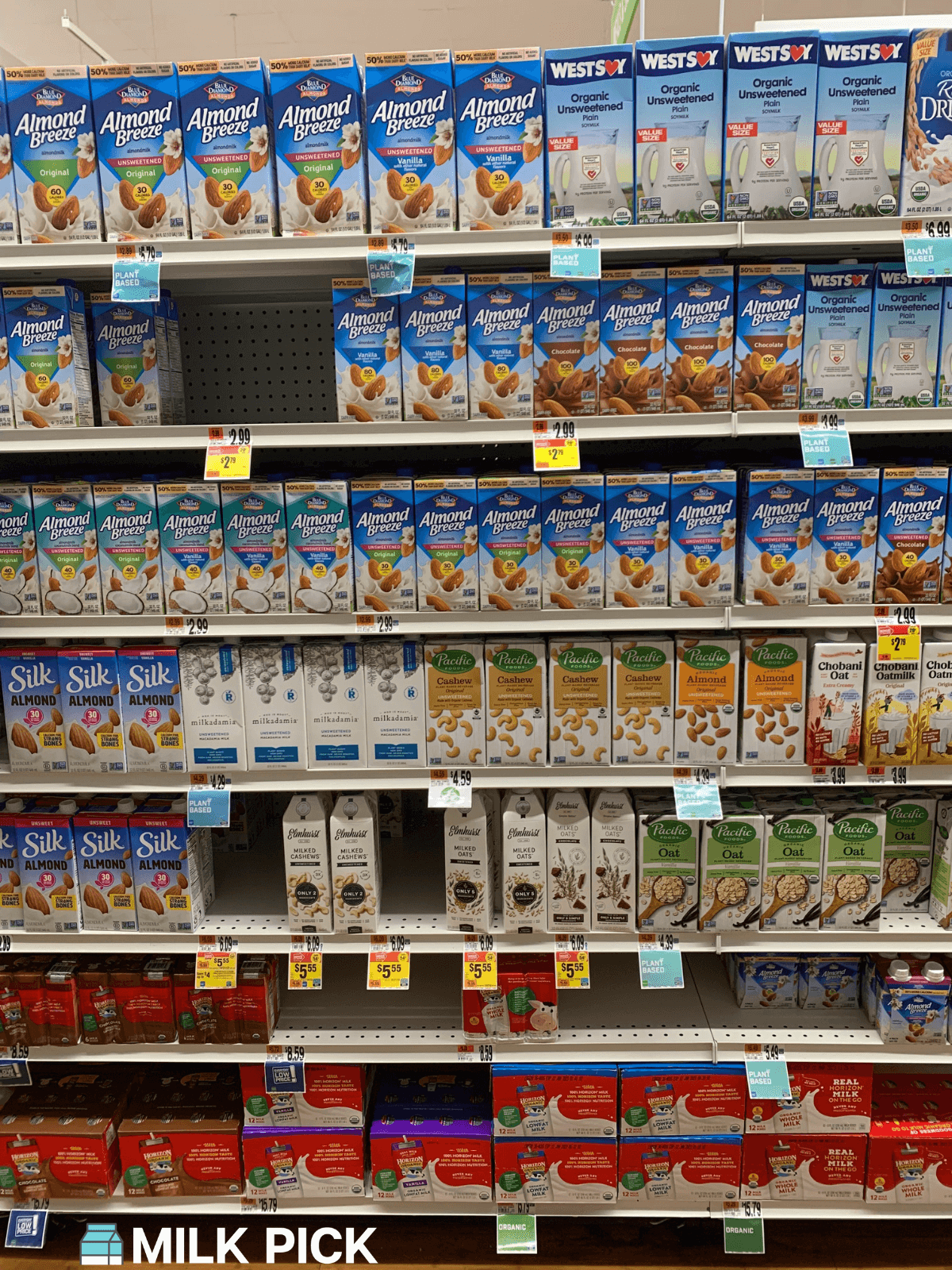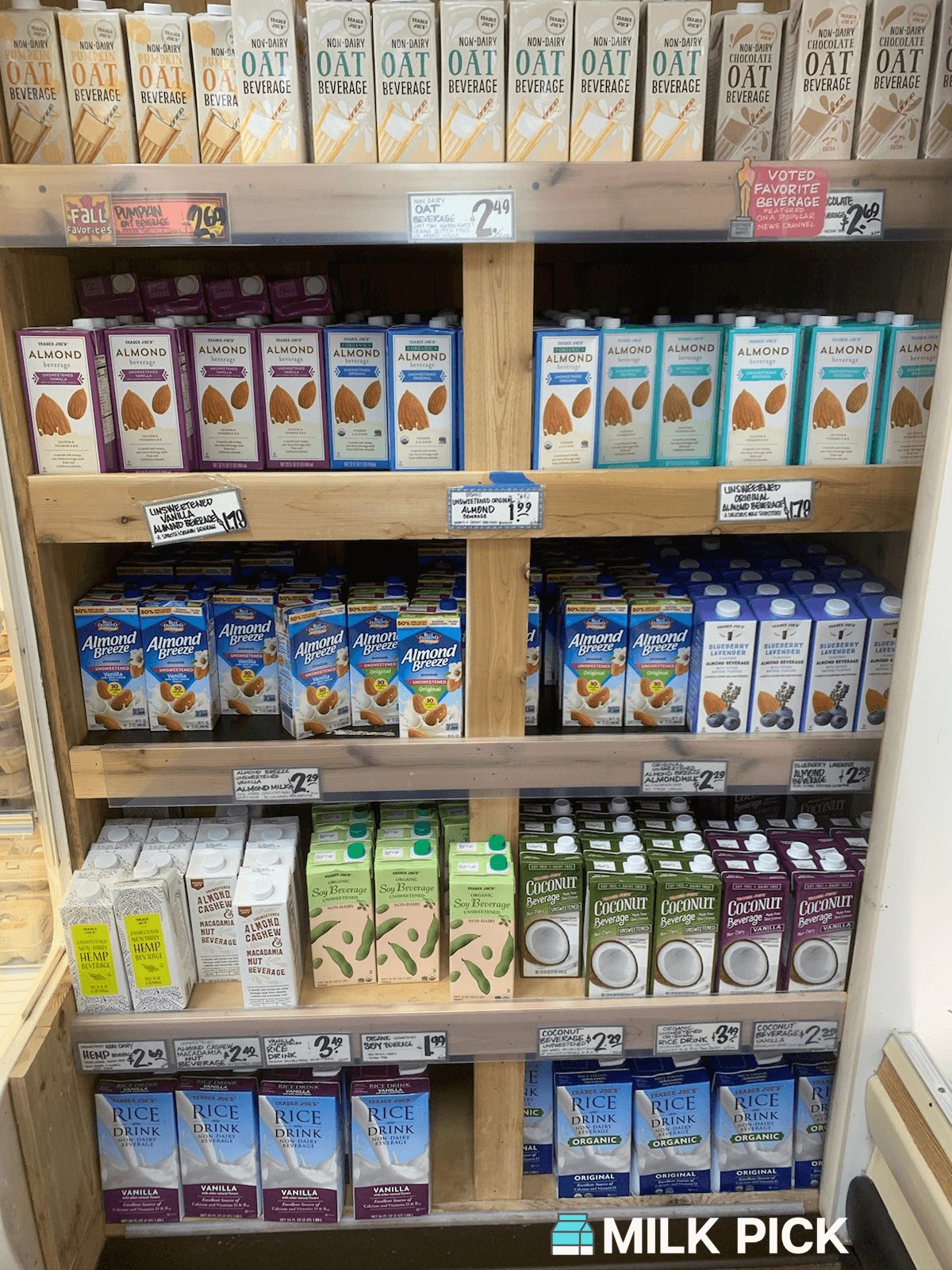Have you ever seen unrefrigerated almond or dairy milk cartons at the grocery store? If so, your first thought was probably, “how do they make shelf-stable milk?”
Shelf-stable milk has undergone ultra-high temperature pasteurization to eliminate bacteria to make it last longer. Shelf-stable milk is safe to consume and comes with its own benefits and drawbacks.
This article will define exactly what constitutes a shelf-stable milk and some of the pros and cons. By the end of the article, you can decide if shelf-stable milk is an option you want to use in your kitchen.
What is Shelf Stable Milk?
All milk undergoes a process called pasteurization. Pasteurization is a fancy word for sterilizing a product to make sure it’s safe to consume.
In the case of shelf-stable milk, they use a higher temperature to pasteurize the milk to fully kill off any bacteria that could develop over time.
Normal milk is pasteurized using a temperature of about 160 degrees Fahrenheit.
Shelf-stable milk is pasteurized with temperatures in the range of 280 to 300 degrees Fahrenheit.
Most shelf-stable milk will last up to approximately 6 months, but this may depend on the temperature at which they are stored.
After you open shelf-stable milk, it should be stored in the fridge and used within 7 to 10 days.
Are Both Dairy and Non-Dairy Milk Shelf Stable?
Shelf-stable milk comes in both dairy and non-dairy forms. And as far as we know, dairy and non-dairy shelf-stable milk have similar shelf lives.
Just like dairy milk, plant-based milk undergoes the same pasteurization process.
This means that plant-based shelf-stable milk is pasteurized using ultra-high temperatures as well.
You can find just about any plant-based milk option in a shelf-stable form at your grocery store. You typically find both milk options in cardboard cartons in a non-refrigerated aisle.

Is Shelf Stable Milk Safe to Drink?
Milk that can last longer outside the fridge sounds great at first glance. But it’s only natural to wonder if shelf-stable milk is actually safe for you.
Research demonstrates that ultra-high temperature pasteurization is effective for eliminating harmful bacteria in shelf-stable milk. This means that it’s perfectly safe for you to drink shelf-stable milk.
What you do need to pay attention to in relation to safety with shelf-stable milk is what you do after opening it.
Once you open the container, you’re breaking the tight seal that’s helping to prevent bacterial growth.
This is why shelf-stable milk needs to be placed in the fridge after opening. And in order to keep yourself safe, you need to consume the milk within 7 to 10 days.
Does Shelf Stable Milk Taste the Same?
A common concern of people purchasing shelf-stable milk is that it won’t taste as fresh as refrigerated milk. This is because most of us associate a longer shelf life with a stale and unfavorable taste.
Most people won’t be able to taste a major difference between shelf-stable milk and refrigerated milk. This is generally true for both dairy and non-dairy milk.
However, a small group of people do report tasting an almost caramelized or cooked flavor in shelf-stable dairy milk.
This is attributed to how dairy milk proteins interact with the high temperatures used to pasteurize the milk.
But if concern about the taste of shelf-stable milk is holding you back from trying it, you probably don’t have anything to worry about.
Is Shelf Stable Milk Cheaper or More Expensive?
In the U.S., shelf-stable milk is generally more expensive than refrigerated milk.
As of October of 2022, the average cost of a gallon of 2% milk is $4.41. This gallon will have 128 fluid ounces.
Shelf-stable milk typically doesn’t come in a gallon size. It’s generally sold in either 8-ounce containers or quart-sized containers, which comes out to 32 ounces.
For a six-pack of 8-ounce shelf-stable milk, you will pay about $10 right now. This comes out to half of the fluid ounces of refrigerated milk for about twice the price.
Thus, shelf-stable milk may not be the most cost-effective option at first glance.
But if you’re only buying once in a while to use infrequently because it doesn’t go bad, it could potentially save you money.
The Perks of Milk that Doesn’t Go Bad
So why would you want to choose shelf-stable milk over refrigerated milk anyways? The obvious answer is it’s nice to have milk on hand that won’t go bad quickly.
How many times have you purchased milk and then forgotten about it, only to let it go bad? You feel wasteful and frustrated when this happens. Shelf-stable milk helps address this problem.
It’s also particularly nice to be able to have milk on hand for cooking and baking. Milk is a common staple for many recipes.
When you can store the milk in the cupboard and pull it out only when need it for a recipe, it takes less planning. You can save yourself a trip to the grocery store by always having milk that’s ready to use.
Environmental Benefits of Shelf Stable Milk
One of the less obvious benefits to shelf stable milk is the positive impact it has on the environment.
There are several ways in which shelf stable milk is good for the environment.
One of them is that there is less energy required to transport the product because it does not have to be refrigerated.
Another notable positive environmental aspect is that the packaging is typically recyclable and more environmentally friendly as they generally use cardboard instead of plastic.

Research shows that using shelf-stable milk can help schools significantly reduce the amount of waste accumulated secondary to expired milk. This means shelf-stable milk may be a good option to help larger organizations significantly minimize their overall waste.
If you want to show Mother Nature a little love, shelf-stable milk might be a good option for you.
Impact of Shelf Stable Milk on Protein Digestion
While shelf-stable milk may be good for the environment, it also comes with some drawbacks. One of these drawbacks is related to the way the protein gets digested.
Researchers found that you digest fewer proteins from shelf-stable dairy milk than milk that is pasteurized by the standard process.
This is thought to be secondary to the effect of the high heat on the proteins themselves.
This will typically only be a concern if you’re drinking dairy milk, as most plant-based milk is not a rich source of protein.
And if you are not drinking milk to meet your protein nutritional needs, then this isn’t a big concern overall. But if you rely on dairy milk as a source of protein in your diet, shelf-stable milk may not be a good choice.
Impact of Shelf Stable Milk on Vitamins in Milk
Another consideration when it comes to shelf-stable milk is its overall vitamin content.
Both dairy and non-dairy milk are often fortified with key vitamins that we tend to be deficient in as a society.
Studies have found that most vitamins do get preserved in shelf-stable milk. However, key vitamins like B6 and B12 were reduced in shelf-stable variations over time.
This is of particular importance if you eat a strictly plant-based diet and use fortified non-dairy milk to get your B12. If you do opt for shelf-stable milk, you will need to be sure to supplement B12 in another form.
Another factor worth noting was the loss of dehydroascorbic acid and folic acid in shelf-stable milk. These nutrients are essential for a healthy pregnancy.
So pregnant women looking for these nutrients in their diet may want to opt for refrigerated milk options.
Shelf Stable or Refrigerated Milk?
Shelf-stable milk is simply milk that’s been pasteurized at a higher temperature to destroy bacteria. This process allows it to last up to 6 months on your shelf at home with no risk to your health.
Shelf-stable milk comes in both dairy and non-dairy forms. Most people report no difference in taste between shelf-stable milk and standard refrigerated milk.
The obvious benefit of shelf-stable milk is being able to have milk on hand that won’t go bad.
A less obvious benefit of shelf-stable milk is that it can help the environment by reducing the waste and energy needed to transport the product.
Shelf-stable milk may reduce overall protein digestion in dairy milk. It also may reduce the amount of certain key vitamins available in both dairy and non-dairy milk. Consider these factors when using milk as a nutritional supplement for your dietary needs.
At the end of the day, shelf-stable milk has pros and cons.
But if you tend to let your milk go bad or never have it on hand when you need it, it might be time to consider adding one or two cartons of shelf-stable milk to your pantry.
